
Reinventing the General Plan
A Project of the California Planning Roundtable
With support from the American Planning Association, California Chapter
Great Model: Riverside County
Featured Principles: Make Life Better, Promote Social Equity and Economic Prosperity, Look Beyond Local Boundaries
- Context
- Changing the Narrative
- Catalyst for Collaboration
- Results Across the Region
- Challenges and Lessons Learned
- Background Information

The Riverside County Healthy Communities Element is the first optional Health Element incorporated into a County’s General Plan in the State of California. This effort emerged from the County of Riverside Department of Public Health’s (DOPH) realization that key aspects of creating healthy communities are determined by planning decisions.
The DOPH recognized a striking correlation between land use and chronic health conditions such as heart disease, asthma, cancer, stroke, and obesity. The DOPH approached the Planning Department with their observations and together they developed the framework for a prospective Healthy Communities Element to be included in the County General Plan The Planning Department then developed appropriate policy language and technical data during a collaborative process with the DOPH and an advisory Healthy Community Working Group.
On May 6, 2009, the County General Plan Advisory Committee discussed an initial draft of the Healthy Communities Element and initially recommended adding the Healthy Communities Element to the County General Plan as part of the comprehensive General Plan update. Later that year, the Healthy Communities Element was fast-tracked with its own General Plan Amendment. Unanimously adopted by the County’s Board of Supervisors in October 2011, the Healthy Communities Element represents the culmination of approximately eight years of skillful strategic planning, capacity building, and collaboration with various stakeholders in a partnership with the Planning Department.
The Healthy Communities Element is the visionary document advancing one of the core principles of planning practice to protect public health and safety. It contains indicators and policies on topics traditionally not found in General Plan Elements, such as social capital, access to healthy foods and nutrition, health care and mental health, recreational centers and day care centers.
This Reinventing the General Plan model highlights three of the most innovative aspects of the Healthy Communities Element:
- Changing the Narrative. The Healthy Communities Element process acted as a catalyst for the DOPH's role as a major driver for making health an important consideration in planning decisions.
- Catalyst for Collaboration. The Healthy Communities Element served as the means to convene non-traditional partners for collaboration in planning.
- Results across the Region. Since the Healthy Communities Element’s adoption, cities across Riverside County and other local and regional agencies have become more receptive to considering health as part of their decision-making processes, resulting in tangible change on the ground.
The Healthy Communities Element is available online.

By incorporating public health into land use planning, Riverside County’s Healthy Communities Element is a catalyst for creating communities where people can live longer and healthier lives. With the adoption of the Healthy Communities Element, a new planning narrative emerged in Riverside County where health outcomes are becoming a stronger factor in planning decisions. By using the factual rationale that health is a critical public issue, Riverside County’s planners have gained broad support for healthy communities planning. The incorporation of key issues such as active living and healthy food access into the General Plan has expanded the substance of the General Plan and increased the number of advocates, among both decision-makers and the public, who support the General Plan. By using planning in a new way to enable residents to make healthy choices, the Healthy Communities Element is in some ways reminiscent of the earliest zoning laws, which focused on protecting people from health hazards.
Riverside County’s inclusion of the Healthy Communities Element in its General Plan is a reaction to the way in which Riverside County has developed, which is based on the ubiquitous auto-centric model and the strict separation of land uses, a development approach that has negatively affected the community’s health. While planning requirements such as the mandatory General Plan elements, CEQA, and local ordinances do protect public health to some extent, the focus on the automobile and single-family subdivisions has contributed to a pattern of sprawling communities that is correlated with alarming health problems, such as obesity and heart disease.
After validating this correlation through epidemiology analysis, officials from the County of Riverside Department of Public Health (DOPH) included in its strategic vision the preparation of the Healthy Communities Element to help reverse this challenging dynamic between auto-centric community development patterns and undesirable health outcomes.
Because of their experience with the implementation of the County’s Safe Routes to Schools program, DOPH staff was well aware of the connection between health and the built environment. The County decided to shift its focus from mitigating the health problems that occur after a development plan has been approved to intervening and preventing health problems before a community has been planned and developed. For example, rather than retrofitting streets to make them safer and more walkable, the County can be designing new streets for walkability as part of its overall policy strategy.
DOPH staff realized that a conversation with the Planning Department needed to begin, but faced a challenge as public health officials did not know very much about planning. DOPH staff began attending outside trainings to help them work with Planning staff to de-emphasize planning for the automobile and include other mobility modes. It was through this DOPH initiative that the conversation with the Planning Department began. While planners commonly plan for trails, sidewalks, and other components of healthy communities, planners do not always see these components through the lens of public health, as ways to combat and prevent chronic diseases – this is the new narrative and vision that DOPH brought to the Planning Department’s table.
By working with the Planning Department to incorporate these ideas into the General Plan, the DOPH could use the General Plan, with its public outreach effort and Board of Supervisors approvals process, to build credibility for planning for healthy communities. The Healthy Communities Element focused on the themes of active living, healthy food access, and multi-modal transportation to create this new narrative where land use planning and public health intersect.
Active Living
With heart disease strongly linked to lifestyle and individual behavior, it is of particular concern that, according to the Health Communities Element Appendix M – Health Indicators, Riverside County ranks an alarming 53rd in heart disease mortality among its population out of the 58 counties in California. In addition, Riverside County has higher rates of obesity than the average for California. The benefits of increasing physical activity are well documented. According to the Centers for Disease Control and Prevention, engaging in regular physical activity is one of the most important steps to improve one’s health. Physical health is vital to Riverside County’s population. For example:
- Heart disease and stroke are both in the top 10 leading causes of death in Riverside County. With at least 150 minutes of moderate-intensity aerobic activity per week, one’s risk of cardiovascular disease is lowered.
- The benefits of physical activity on bone, muscle, joint strength, and cognitive functioning are particularly important to Riverside County’s rapidly growing aging population. It has been proven that regular physical activity slows the loss of bone density and strengthens muscles, which is important for residents to perform the essential daily activities of living independently. Regular physical activity can help keep thinking, learning, and judgment skills sharp as one ages.
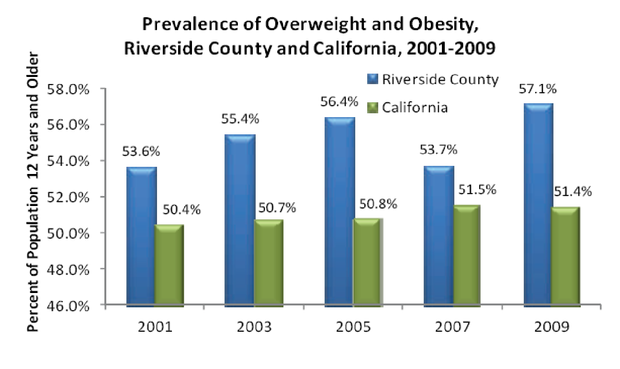
Source: Riverside County Community Health Profile, 2013
When people have more choices for an active lifestyle (parks, open space, trails, etc.), the benefits of physical activity can be realized. The Healthy Communities Element promotes healthy behaviors and increases opportunities for physical activity, as illustrated by the following policy:
HC 2.2 Promote increased physical activity, reduced driving and increased walking, cycling and public transit by:
- a. Requiring where appropriate the development of compact, development patterns that are pedestrian and bicycle friendly.
- b. Increasing opportunities for active transportation (walking and biking) and transit use.
- c. Encouraging the development of neighborhood grocery stores that provide fresh produce.
Healthy Food Access
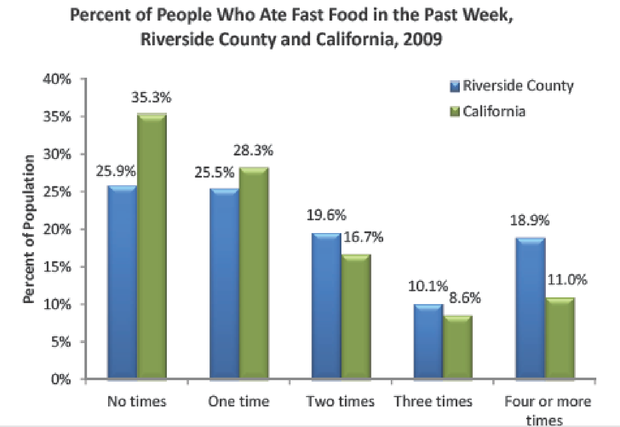
Source: Riverside County Community Health Profile, 2013
The Healthy Communities Element reflects the knowledge that better access to healthy foods improves community health. “Access” refers both to the proximity of food outlets and the quality of food available. Both types of access have an impact of health. Studies have shown there is a direct relationship between the availability of fresh food outlets and consumption of fresh foods. For example, in one such study, researchers found that for every additional supermarket in a census tract, produce consumption increased by 32% for African Americans and 11% for whites. The quality of the food available is also a factor in community health. For example, in another study, researchers calculated that for each additional meter of shelf space devoted to fresh vegetables, residents consumed an additional 1/3rd of a serving per day. Improving access to healthy foods increases the consumption of healthy foods, and it is unequivocal that increased consumption of healthy foods reduces the rates of diet-related diseases and obesity.
The following Healthy Communities Element policies articulate the County’s goal to increase access to healthy food choices:
HC 11.1 Improve access to fresh fruits, vegetables, and other healthy food by encouraging a mix of food establishments that offer healthy food choices.
HC 11.2 Promote the production and distribution of locally grown food by reducing barriers to farmers markets, food cooperatives, neighborhood or community gardens, ethnobotanical gardens, etc.
Multimodal Transportation
There are many reasons to support multimodal transportation systems and choices, and the Healthy Communities Element adds the health benefits to the rationale. Transportation policies and regulations can clearly have direct health benefits – for example, by reducing drinking and driving or increasing seatbelt use. But transportation policies can also improve health indirectly. A person’s transportation options, or a lack of options, can determine the frequency and/or availability of healthy lifestyle choices, such as making regular doctor visits, acquiring good jobs, and accessing healthy food. This is especially true for children, older adults, and households without automobiles.

Photo Credit: Riverside County Transportation Commission
When health is factored in as a key objective of transportation and land use policy, the resulting decisions can help reduce air pollution; prevent traffic injuries and deaths; and lower obesity, diabetes, cardiovascular disease, and cancer rates. Such outcomes can happen when roads are designed to be pedestrian-, cyclist-, and public transit-friendly. Roads that are designed for people, as well as for cars and trucks, can increase opportunities for physical activity, enhance community quality of life, and increase access to community services.
The following two Healthy Communities Element policies illustrate how this new narrative is being brought into the planning practice. They provide big-picture approaches to improving multimodal transportation, rather than specific solutions or directives:
HC 6.1 Coordinate with transportation service providers and transportation planning entities to improve access to multi-modal transportation options throughout the County, including public transit.
HC 6.2 Coordinate with transportation service providers and transportation planning entities to address the location of civic uses such as schools and government buildings, commercial corridors, and medical facilities so that they are accessible by public transit.
Perhaps one of the greatest achievements of the Healthy Communities Element for the DOPH is that the DOPH now has more opportunities for involvement to continue to change the narrative. No longer is the DOPH the only party advocating for health in the county – healthy goals are now a part of the General Plan itself, with the support of elected officials and the Planning Department. Since the Element was adopted, the DOPH has been involved in the entitlement for land use development approval process in an unprecedented way. Today, DOPH staff reviews plans and is regularly involved in meetings with developers to discuss how to incorporate healthy planning into projects. Public health project review comments are given the same weight as other Department (e.g. Transportation, Public Works, Parks) comments during the entitlements process. The Element also provides opportunities to use emerging analytical tools. For example, a Health Impact Assessment is currently being considered for a major project for the first time: CV Link, a 56-mile multi-modal trail for golf carts, pedestrians, and bicycles in the Coachella Valley. The Health Impact Assessment goes beyond the CEQA process, which adds an important health dimension that helps identify and develop mitigation measures (e.g. related to walkability) to protect human health in a way that planners have not typically done in CEQA documents. Never before has health been given such consideration in the County’s planning process.

The Healthy Communities Element is a tool to summon non-traditional partners to collaborate on planning issues. These public health partners add their understanding of public health data and needs to the planning conversation, reinforcing many current planning principles and increasing the factual support for creating more walkable communities, building parks, etc. The affinity between public health and planning began when land uses were separated to address detrimental health conditions in crowded cities at the turn of the twentieth century. Since then, each discipline has evolved to focus on separate issues for various valid reasons and has developed a specific network of other professions to solve pressing issues. For example, public health officials work closely with nutritionists, epidemiologists, and medical doctors to prevent and cure disease, while planners collaborate with civil engineers, architects, and urban designers to plan for orderly development. Planning for healthy communities is bringing public health officials and planners back together.
Riverside County is using the Healthy Communities Element to spark this collaboration in two ways: first, by making the Healthy Communities Element available as a model General Plan Element for local cities to use; and second, through the Riverside County Health Coalition, a partnership representing vast segments of the community coming together for healthy communities planning.
Model General Plan Element
The Healthy Communities Element is more than just a plan. It provides the opportunity for public health and planning professionals to synergize like never before. And the Healthy Communities Element has enabled the County of Riverside Department of Public Health (DOPH) to reach out to every city in the county to encourage them to adopt similar polices. The Western Riverside Council of Governments has used the County’s document to create a template for all its member jurisdictions so that when they are ready to consider health, they can collaborate with the Riverside County DOPH to adjust and customize their own document. In the Coachella Valley, with the leadership of the Clinton Health Matters Initiative and the Coachella Valley Association of Governments, all of the Cities’ General Plan policies in the Coachella Valley have been evaluated for alignment with the County’s Health Communities Element.
Riverside County Healthy Coalition
The DOPH has created the Riverside County Healthy Coalition as part of the implementation of the Healthy Communities Element. The Coalition is a public/private partnership that is a crucial component of the Element’s implementation strategy to bring together collaborative partners, engage local cities, and conduct ongoing outreach. New partners who engage in planning enrich the discussion and provide planners with a deeper understanding of key community issues. The Coalition mobilizes partners from multiple domains, provides leadership and vision, and coordinates countywide efforts for healthier living throughout the county.
The Coalition meets quarterly and has two strategic subgroups that regularly convene to work on action plans. The first subgroup, Food Access, is examining issues related to the food environment in Riverside County in order to identify ways to improve and promote access to healthy foods. The subgroup is working to define healthy retail and is conducting an assessment of the various establishments (and their quality) using County Nutrition Action Plans (CNAP) reports, CX-3 (Communities of Excellence) data and other mapped data resources. The Food Access subgroup also plans to work on a food delivery co-op to facilitate delivery of healthy foods to local corner stores, piloting in the Eastside area of Riverside.
The second Coalition subgroup is working on the Healthy City Resolution and is comprised of individuals from a diverse expertise, elected officials and representatives from local cities, Metropolitan Planning Organization (MPO) and Council of Governments (COG) representatives, the South Coast Air Quality Management District, a breastfeeding specialist, a health foundation representative, and representatives from the Clinton Foundation, the National Safe Routes to Schools Coalition, and Loma Linda University. During the 2013-2014 year, this action group is working on three fronts: 1) developing a toolkit, 2) building relationships, and 3) creating a marketing plan.
The Healthy City Resolution subgroup promotes healthy policies in the General Plan in 15 cities in Riverside County. As a first step to achieve this goal, the group is promoting the adoption of a healthy city resolution stating that health is an important aspect in decision making processes—particularly in those related to the built environment. The County suggests that cities adopt such a resolution through one of the following methods: 1) by adopting a resolution expressing the City’s support of the County’s Healthy Riverside County Resolution; or 2) by adopting a resolution developed by the Healthy Eating Active Living (HEAL) Campaign.
The County learned the importance of making progress in small steps, by using the County’s “Healthy Riverside County” resolution to first begin the conversation about healthy planning and then encourage the development of healthy planning policies. The idea of this path of action (resolution first, policy-making second) came from two Deputy Directors from the DOPH. The County has seen success with this approach. The County’s Healthy Riverside County Resolution has paved the way for decision makers in local jurisdictions to support the inclusion of Healthy Communities Elements in their own General Plans. Riverside County DOPH staff has successfully persuaded eight cities to incorporate health into planning. In some cases, cities are preparing their own Healthy Communities Elements, and in others they are using the County’s Element as part of their own General Plans.
This incremental change in which health is considered in planning policy is expected to contribute to the current statewide (e.g., Health in All Policies) and regional (e.g., the recently approved Regional Transportation Plan by the Southern California Association of Governments, which contains a health component) efforts taking place. This catalyst for collaboration is propelling efforts to break the traditional silos that up until recently provided inadequate unilateral solutions to problems requiring multidimensional approaches.
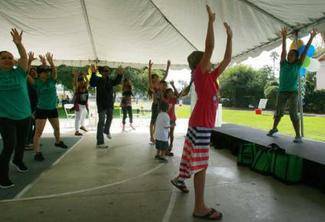
As part of the County’s General Plan, the Healthy Communities Element applies only to areas within the County’s jurisdiction. Since its adoption, however, the Healthy Communities Element has had a noticeable impact on the ground in the communities in Riverside County that have adopted a Healthy City Resolution or Healthy Communities General Plan Element.
While organizations in Riverside County have been advocating for healthy living issues since before the County developed the Healthy Communities Element, the new narrative for healthy planning among planning professionals and other County officials has provided new support for these efforts. Timing has also proven to be important. The Healthy Communities Element has sparked discussion and political support at just the right time for some areas of the county. Public health advocates are seeing a real impact, from countywide decision-makers to city officials to residents at the neighborhood level. In some instances, change is occurring slowly, but in other instances the impact has been evident very quickly. One such instance is in the Eastside HEAL Zone in the City of Riverside.
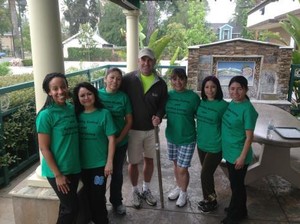
The HEAL (Healthy Eating, Active Living) campaign was developed by Kaiser Permanents and has been established in cities across California to expand healthy living opportunities in neighborhoods. In the Eastside area of Riverside, a HEAL Zone has been created and the HEAL Campaign efforts have benefitted from the partnerships and conversations that developed as part of the Healthy Communities Element. The government’s support for healthy living has provided support for community groups, and decision-makers are coming together to produce results.
A Community Action Plan developed for the Eastside HEAL Zone illustrates the continued collaboration that exists for healthy planning in Riverside County. For example, the Community Action Plan identifies the following players and strategies, among others:
- The City of Riverside’s Community Development Department is leading an effort to promote healthy food outlets. This includes assisting markets to expand healthy food options, developing new farmers markets, and helping to establish community gardens.
- The City of Riverside’s Parks, Recreation, and Community Services Department is increasing the safety of parks by increasing positive police presence. The Department has also established a healthy vending policy to provide healthier food options at parks.
- The Riverside Unified School District is expanding its breakfast program, providing nutrition education, and equipping its teachers and afterschool leaders with tools to lead physical activity and nutrition education.
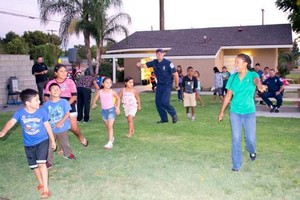
In Eastside Riverside, and other areas of the county, public health professionals report that their work is becoming easier now that all of these players are on the same page. Just as the Healthy Communities Element itself was developed out of a changed narrative and new collaboration among County planners, the implementation of the Element has continued to change the narrative and bring about new forms of collaboration throughout the county.
(Photo Credit above: The Press-Enterprise)
Challenges:
- Political support. The development and adoption of the innovative Healthy Communities Element is a major success for Riverside County, which has traditionally been more conservative in its planning approach. While County staff report that they would have liked the Element to contain more prescriptive policies, e.g. more “shalls” than “shoulds,” staff recognize that the Element is a success given the context in Riverside County. As part of the consideration and adoption of the Element, to address potential concerns about healthy planning, staff prepared a staff report showing that the Element would have no fiscal impacts.
- Turn over of key supporters. During the preparation of the Healthy Communities Element, the leadership at the Planning Department changed. It proved to be important that DOPH staff had not only developed a relationship with the new Director, but with other key long range Planning staff who could diligently move the Element to a point ready for public hearing.
- DOPH budget and staffing. The DOPH encountered its own turnover as well. Budget cuts led to layoffs and early retirements, reducing the capacity of the Department to develop the Element.
Lessons Learned:
- Persevere. With the turnover of staff, momentum for any project can waver. In working with the Planning Department during a period of change at the leadership level, DOPH staff learned that perseverance and persistence would be crucial to the success of the Healthy Communities Element. For example, when Planning staff needed to cancel meetings about the Element due to other pressing needs in the Planning Department, DOPH staff were quick to reschedule, making sure that the Element remained a priority for both departments.
- Find many champions. Because healthy planning was new for the County, and a new policy area for most planners, it was important that the Element had broad support. DOPH staff worked to forge bonds with planners, for example by inviting planners to conferences where they could see the value of adding health to planning.
- Seize your opportunity. The Element was initially intended to be a part of the County’s comprehensive General Plan Update. It was later decided that the Element should be adopted during one of the County’s four General Plan Amendments allowed per year. County staff learned that you do not have to wait for a General Plan Update – you can use regular General Plan Amendment process to add healthy planning to your General Plan. This allowed the Element to hit the streets earlier.
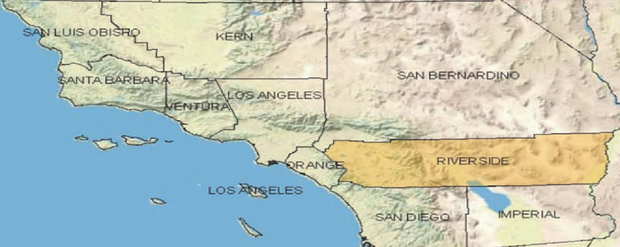
Riverside County is geographically the fourth largest county in California, stretching nearly 200 miles across and covering 7,200 square miles. The population is currently estimated at 2.1 million, after increasing 44% in the last decade. Riverside County has frequently been ranked as the fastest growing county in the state. If current projections hold true, the County population will reach 4.7 million by 2050, making it the second most populous county in the state. Much of this growth has occurred in unincorporated areas as commuters and retirees from neighboring counties have come in search of affordable housing.
While infectious diseases often receive much publicity, the real and continually growing threat to Riverside County’s community’s health is due to chronic disease. The diseases and health conditions that currently reduce the productivity and quality of life of Riverside County residents are intricately entwined with daily routines. Daily routines are shaped by the circumstances residents encounter in their homes and by the neighborhoods and streets that surround and connect residents to their jobs, retail outlets, and each other. The risks from being physically inactive, eating poorly, breathing bad air, and having stress and depression does not immediately result in poor health. However, data show that the presence of these risks over a number of years is associated with the leading causes of death and illness in Riverside County.
For example, when obesity levels rise, so too will the number of Riverside County residents who die from the current leading causes of death: 1) heart disease, 2) cancer, and 3) stroke. The death rates for all of these conditions were higher in Riverside County than in California, as were death rates for lung disease (COPD) and unintentional injury. Other illnesses like diabetes, asthma, and lung disease are also related to the direct and indirect effects of built environments that discourage physical activity, promote unhealthy eating habits, and increase exposure to environmental toxins in the air, water, and soil.
Community Description
Size: 7,295.6 square miles
Population: Since 1990, Riverside County’s population has nearly doubled, from 1,170,413 in 1990 to 2,189,641 in 2010.
Major Industries: Retail Trade, Educational Services, Health Care and Social Assistance, Accommodations and Food Services, Manufacturing and Administration & Support, Waste Management and Remediation
Median Income: $58,365 in 2011
Demographics: According to the 2007-2011 American Community Survey, 45% of Riverside County residents are Hispanic, 40% are white, 6% are African American, 6% are Asian, and 2% are two are more races. 32% of the county’s population is under the age of 20, 34% is aged 20 to 44, 23% is aged 45 to 64, and 12% is over the age of 65.
Timeframe of Plan Development
2003: Initial conversations about the Healthy Communities Element began. The next few years were focused on building relationships between Public Health and Planning staff, leading up to the development of the Element.
2006/2007: The work on the Healthy Communities Element began.
2011: The Healthy Communities Element was adopted.
Overall Vision of Plan
The General Plan Vision speaks of the importance of promoting a healthy living environment for all residents. The Healthy Communities Element provides a framework for translating the General Plan vision for a healthy Riverside County into reality by identifying policies to achieve that vision. The Healthy Communities Element addresses areas where public health and planning intersect, including transportation and active living, access to nutritious foods, access to health care, mental health, quality of life, and environmental health.
Public Participation and Stakeholder Involvement
Public participation was not a major component of the Element’s development. County staff was focused on getting the Element adopted. It is through the implementation of the Element that the public has become involved in the various aspects of healthy planning and healthy living campaigns. See the “Catalyst for Collaboration” and “Results across the Region” tabs for more information on how the Healthy Communities Element is being implemented.
Other County Departments' Involvement
Key departments included the County Departments of Public Health, Planning, Transportation, Parks and Recreation, Office on Aging, and Environmental Health.
Legal and Policy Context
The Healthy Communities Element is allowed by Section 65303 of the California Government Code, which allows a County or City to include optional element(s) in its General Plan.
Consideration of Regional Issues
As a County document, the Healthy Communities Element plans for the health of the entire county. The Element serves as a model for local Cities. The County is also working with smaller Councils of Government and Associations of Governments.
The Riverside County Healthy Coalition is working with other regional bodies that go beyond the county itself. The Western Riverside Council of Governments (WRCOG), Southern California Association of Governments, and Coachella Valley Association of Governments participate in the Coalition. See the “Catalyst for Collaboration” tab for more information on the Coalition.
WRCOG received a grant to work on a Healthy Communities Element. WRCOG has created an Element using the Riverside County Healthy Communities Element as a template, taking into consideration three other Healthy Communities Elements as well.
Community Reaction
The community’s reaction can be best gauged through the successes of various groups working with the community on various health issues, e.g. nutritionist groups. The HEAL (Healthy Eating, Active Living) Campaign, funded by a $1 Million grant, serves as an indicator of the community’s reaction. These efforts are well received. Although a lot of county residents do not know about the Healthy Communities Element itself, stakeholders who work directly with community (e.g. food banks) are excited about the Element and want to be a part of next update. See the “Results across the Region” tab for more details.
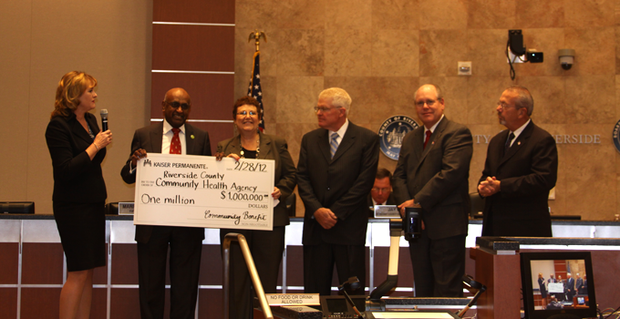
Implementation Features
The implementation of the Healthy Communities Element lies in the work that continues to improve health in Riverside County. See the “Catalyst for Collaboration” tab for a discussion of these ongoing efforts.
Connection to Jurisdictional Budget
Healthy Community Element Consultants: Raimi + Associates $25,000
All other work done in kind from existing DOPH budget, with existing staff.
Adaptability
As part of the General Plan, the Healthy Communities Element will be updated to adapt to changing health trends and issues in Riverside County as part of regular General Plan Updates.
Accessibility
The Healthy Communities Element is available online at the Riverside County Transportation & Land Management Agency Website.
Graphics and Presentation Quality
The Healthy Communities Element does not include graphics.
Organization
Policies in the Healthy Communities Element are divided into sections corresponding to the following important health issues:
- Overall health
- Land use and community design
- Healthy transportation system
- Arts and culture
- Social capital
- Parks, trails, and open space
- Access to healthy foods and nutrition
- Healthcare and mental health care
- Schools, recreational centers, and childcare
- Environmental health
Costs
$25,000 for Raimi + Associates, Planning Consultants
Other costs: Staff time
Actual Costs vs. Expected Costs
In terms of consultant expenses, there were no unexpected costs. In terms of staff time, dozens of hours were worked beyond what was expected to meet with Planning Staff, County Counsel, and other County Departments.
Adoption Process
- October 21, 2008: County initiated the General Plan Amendment (GPA960)
- May 6, 2009: GPAC discussed an initial draft of the Healthy Communities Element and recommended adding it to the General Plan Amendment effort.
- June 24, 2009: First Planning Commission public hearing on the Healthy Communities Element. Planning Commission indicated general support for the new optional Element.
- October 7, 2009: Created stand alone General Plan Amendment for the Healthy Communities Element, to allow the Healthy Communities Element to be adopted on a faster timeline than the rest of the General Plan Amendment. The General Plan Amendment also covered related revisions to General Plan Chapter 1 (Introduction) and Chapter 2 (Vision Statement), and a new Appendix (M: Health Indicators).
- March 23, 2011: Healthy Communities Element adopted.
CEQA Review
A Negative Declaration was prepared for the General Plan Amendment.
Legal Challenges
None.
Planning Staff and Consultants
County of Riverside Planning Department: Mitra Metha-Cooper, AICP; Josh Lee; Phayvanh Nanthavongdouangsy; Kristi Lovelady; Carolyn Syms-Luna
County of Riverside Department of Public Health: Michael Osur, MBA; Marsie Huling
Consultant: Matt Raimi, AICP, LEED, Raimi+Associates
Accessing the Plan
The Healthy Communities Element is available online.
Name of CPR Preparers of this Model
Miguel Angel Vazquez, AICP
Name of Primary Points of Contact at the Jurisdiction
- Miguel Angel Vazquez, AICP
- Michael Osur, MBA
- Kristy Lovelady
Date Reviewed by Jurisdiction
November 21, 3013
CPR Peer Reviewers
- Linda Dalton, FAICP
- Al Zelinka, FAICP, MSM
- David Booher, FAICP
CPR Project Team
- Elaine Costello, FAICP, Project Manager
- Co-Chairs Cathy Creswell and Janet Ruggiero, FAICP
- Alexis Mena, Project Assistant
The Catalog
Our catalog contains a number of General Plan "Great Model" examples. Browse the entire catalog
Browse by Principle
- Create a Vision
- Manage Change
- Make Life Better
- Build Community Identity
- Promote Social Equity and Economic Prosperity
- Steward and Enhance the Environment
- Engage the Whole Community
- Look Beyond Local Boundaries
- Prioritize Action
- Be Universally Attainable
Browse by tag:
awards city climate-change context county equity graphics growth-management health implementation infill mature-community organization participation preservation redevelopment region rural smart-growth suburban sustainability town urban urban-design web-strategies